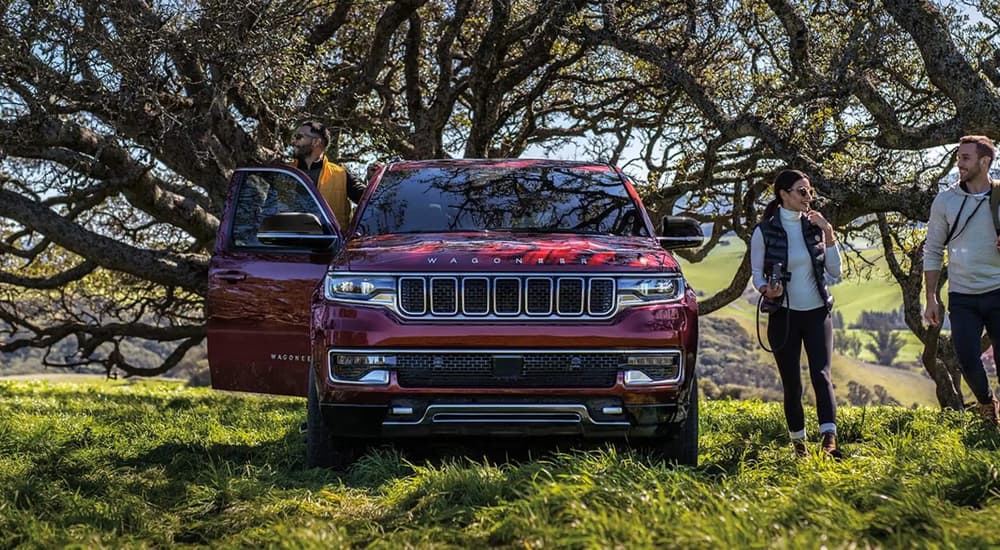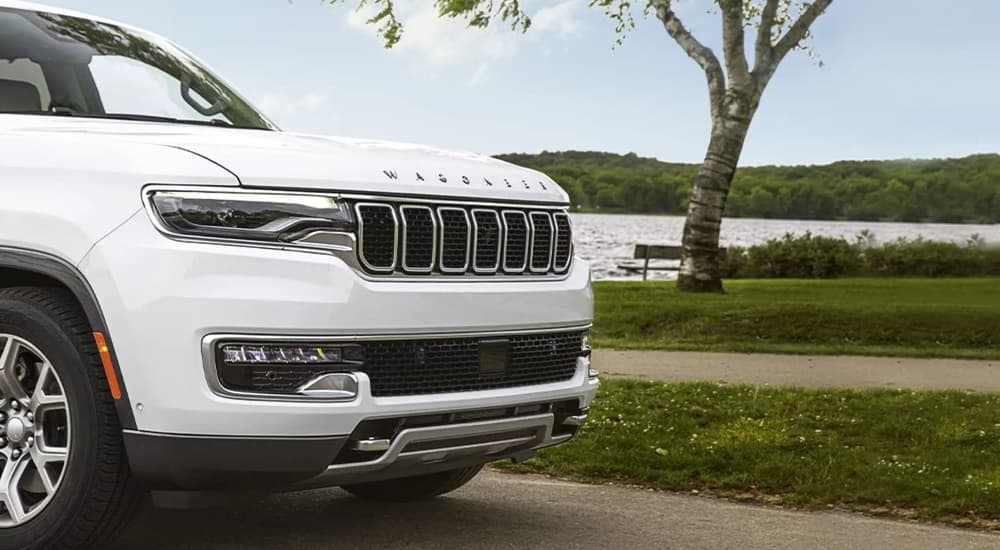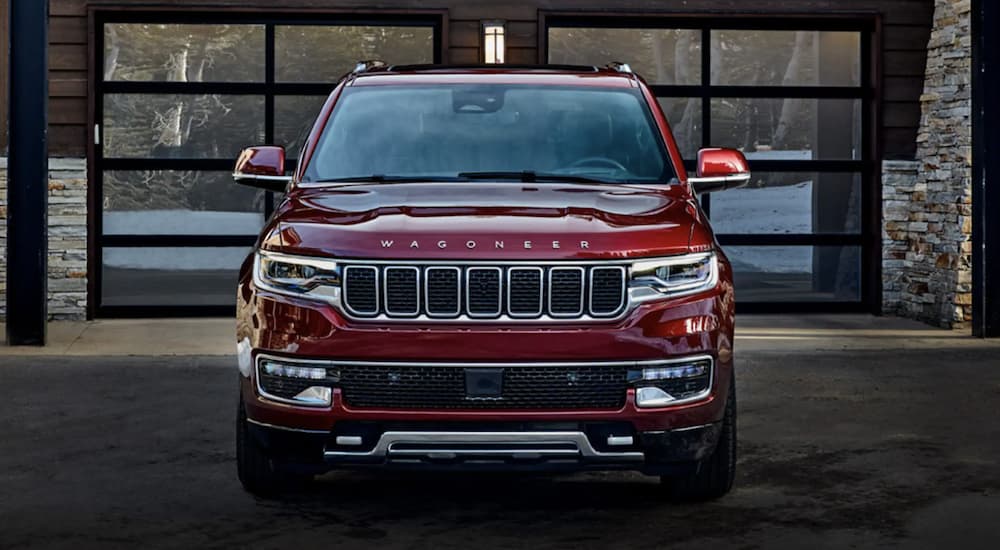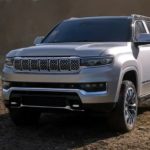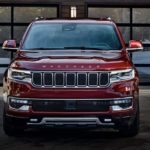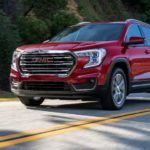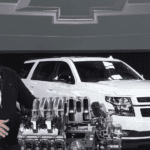When Jeep began offering the Wagoneer for sale again in 2021 following a 30-year hiatus, it entered a full-size SUV market that was much more crowded than when it left. S&P Global reports that, as a percentage of the overall car market, full-size SUV sales have nearly doubled over the past decade, going from 1.9% in 2013 to 3.5% in 2023.
Almost every major automaker has at least one full-size SUV in its lineup. The biggest names in the marketplace, though, belong to America’s two most famous brands: Chevy and Ford. The Chevy Tahoe and Ford Expedition continue to lead the way, with the Tahoe selling 110,328 units in 2023 and the Expedition taking second at 73,396. Has the Wagoneer succeeded in taking a bite out of these venerable models? Today’s guide attempts to answer this question.
More Power and Torque for More Adventures
While some people buy full-size SUVs to shuttle kids to basketball practices, others buy them to push boundaries. You need power and torque to drive over rocks and dunes or climb mountains. According to the EPA, average vehicle horsepower more than doubled from 103 hp in 1980 to 247 hp in 2020—but you can’t tackle extreme trails with average power.
The Jeep Wagoneer only sports one powertrain option, but it’s a doozy. The Hurricane Twin-Turbo engine is the heir apparent to the beloved HEMI, and it delivers 420 hp and 468 lb-ft of torque. That’s some serious pull for rock crawling or the highway. If you enjoy some thrills, it has a great launch as well, going from zero to 60 mph in around 5.5 seconds.
The Tahoe and Expedition each have multiple engine options, but they show more isn’t necessarily better. The base Tahoe 5.3L V8 gives you a relatively paltry 355 hp and 383 lb-ft of torque. The Duramax turbo-diesel and 6.2L V8 offer 460 lb-ft, which still doesn’t quite touch the Wagoneer’s Hurricane—and while the 6.2L V8 has 420 hp, the diesel engine only puts out 277 hp.
As for the Expedition, every trim uses some variation on the 3.5L EcoBoost V6. There are three different levels of power available, depending on the trim, but the only one that can touch the Wagoneer is the Timberline, with its 440 hp and 510 lb-ft of torque. The other trims come up short in horsepower, torque, or both. And unlike Chevy or Ford, you don’t have to upgrade to an expensive Wagoneer trim to get a hotshot engine. Even the lowest-level Wagoneer Series I gets the same 420 hp Hurricane, meaning high-end power and torque for everybody.
Improved Economy for More Time Off-Roading
If you’re constantly having to cut trips short because you’re low on fuel, your adventures will feel unfulfilled. Not only that, but your budget will run dry quickly. It’s not surprising that fuel efficiency ranks as an important factor when buying a vehicle for many shoppers.
In this regard, the Jeep Wagoneer is a great SUV for drivers. No full-size SUV will get incredible gas mileage, but the Wagoneer does better than most. The 2024 model gets an EPA-estimated 20 MPG combined in two-wheel drive and 19 MPG combined in four-wheel drive. That means up to 530 miles of exploration—enough to spend the day on the road and still have enough gas to go to dinner afterward.
For comparison, the 2024 Chevy Tahoe, with its 5.3L V8 engine, gets an EPA-estimated 17 MPG combined—and that’s with 65 less horsepower. That means a total range of 408 miles, so you might end up pausing your adventures to hunt down a gas station. The optional 6.2L V8 is even worse, getting 16 MPG combined with a range of 384 miles. The Duramax diesel engine option offers a remarkable 24 MPG combined and 576 miles of range, but diesel fuel is usually more expensive than regular gasoline, and diesel engines require additional care.
As for the 2024 Ford Expedition, you’re looking at an EPA-estimated 19 MPG combined for two-wheel drive and 18 MPG combined for four-wheel drive. Although not as big a gap to the Wagoneer mileage-wise, the fuel tank in the Expedition is noticeably smaller. Together, this means its range is almost 100 miles lower than that of the Wagoneer at just 441 miles.
More Cargo Space When Your Friends Come Along
Many SUV manufacturers advertise how much cargo room is available when all the seats are down. While this is fine for solo adventurers, we know most of you don’t want to go it alone—you want to bring family and friends. Otherwise, you probably wouldn’t be buying a full-size SUV. Therefore, it’s important to look at the cargo capacity when the seats are being used so you know how much everyone can pack.
The Jeep Wagoneer scores another decisive victory here. With all seats in the upright position, the Wagoneer offers a best-in-class 27.4 cu.ft. of cargo space. That is 7.5% more than the Chevy Tahoe, which has 25.5 cu.ft. when the whole gang is along for the ride. The Ford Expedition, meanwhile, has only a 20.9 cu.ft. cargo bay. The Wagoneer is the way to go if you want to bring lots of people and cargo along for lots of thrills.
The Best Towing Capacity in its Class
Of the many reasons to get a full-size SUV, towing stands out. You want an SUV that can pull your watercraft, camper, UTVs, and other toys with ease—and unlike with a truck, you can have up to seven friends sitting comfortably in the vehicle as you do. Roughly a quarter of SUV owners use their vehicles for towing, so having good capabilities for these occasions is a must.
For hauling capabilities, the Wagoneer wins again. It can tow up to 10,000 lbs, making it the leader in the full-size SUV segment. The Expedition tops out at 9,300 lbs, which requires adding a separate heavy-duty tow package. The Tahoe is the worst of the trio at 8,400 lbs. When you need to do serious hauling, the Wagoneer has the brawn to make it happen.
Sales Still Lag…for Now
In terms of performance and comfort, not only has the Jeep Wagoneer successfully challenged the Chevy Tahoe and Ford Expedition, but in many ways, it has blown right past. This is a vehicle with serious power, torque, efficiency, pulling capacity, and cargo space for people serious about using their full-size SUVs as they were originally intended.
Yet when you look at sales numbers, the Tahoe and Expedition still have a big lead. In 2023, the Wagoneer sold 29,149 units—a decrease of just over 7,000 vehicles from 2022. While that’s more than established options like the Toyota Sequoia and Nissan Armada, it’s roughly 40% as many SUVs as the Ford Expedition and barely 26% of Tahoe sales.
The good news for Jeep, though, is that the gap is narrowing. Sales for 2023 finished strong, and in the first quarter of 2024, the brand moved 13,130 Wagoneers—a 136% increase over Q1 2023. Meanwhile, Tahoe Q1 sales were down 14% year over year, and Expedition sales were up a modest 11.4%.
This seems to indicate that people are starting to respond to the benefits of the Jeep Wagoneer. On the other hand, a major mid-cycle refresh has been confirmed for the 2025 Tahoe, and reports are the Expedition will also get an update. Even with recent sales on the rise, Jeep will have to stay on top of its game to keep eating into Chevy and Ford’s lead.
